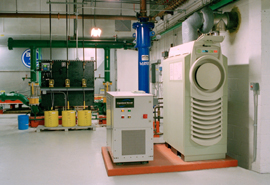
A scale model of his idea is now an exhibit at the Henry Ford Museum in Dearborn, Mich. Clearly, Fuller was on to something. Fast forward 80 years and that something is the "green building."
Technically, these edifices conform to a set of environmental design and performance guidelines established by the U.S. Green Building Council, and they come in various shades of green as arrived at by the council's Leadership in Energy and Environmental Design (LEED) rating system. What they all have in common is an astonishingly low impact on the environment.
Typically, they save close to 30 percent of the energy and 50 percent of the water that buildings of comparable size waste. Turning a building green might entail hardening the interior walls with insulation, applying special glazing to windows and installing high-efficiency lighting, heating, cooling, and ventilation systems. It might also involve new plumbing fixtures emphasizing water conservation. Then, to ensure clean ambient air and water quality, contractors typically agree to avoid using toxic paints, sealants, cleansers, and floor coverings, and use special filters and monitoring equipment to reach clean-room levels of air and water purity.

Three years ago, I led a team that created the nation's first "green" residential high-rise building: The Solaire, at 20 River Terrace in New York's Battery Park City, which achieved levels of energy efficiency 35 percent greater than prescribed by the state's energy code. The Solaire consumes 65 percent less energy during peak summer periods than buildings of comparable size and relies on solar energy for 5 percent of the building's base electrical load. The building even includes its own wastewater treatment facility - the first in the nation inside a multi-family residential building - alongside another innovative system that re-uses storm water.
The impetus behind The Solaire was Gov. George Pataki, who has been advancing a pragmatic environmentalism since assuming the governorship more than 11 years ago. The governor spearheaded legislation to provide significant tax relief to developers of green buildings. He also mandated a 35 percent cut in energy use at state buildings by 2010 - in effect, ordering state buildings to turn green as well.

Today, state office buildings, the state university system, housing projects, schools, libraries - even police precincts and fire houses - are astonishingly energy efficient, despite the majority of these structures having been built in an era when energy was cheap and plentiful. These green enhancements save taxpayers $92 million through reduced energy and maintenance costs and avoid the importation of more than 1.5 million barrels of foreign oil every year.

Down the road, we plan to achieve a LEED-certified rating on our corporate office building in White Plains, as we improve water efficiency, air purity, and the other attributes of building performance.
Timothy S. Carey is president and chief executive officer of the New York Power Authority. Among his former positions was that of president and chief executive officer of the Hugh L. Carey Battery Park City Authority.
Publication date: 06/26/2006

Report Abusive Comment